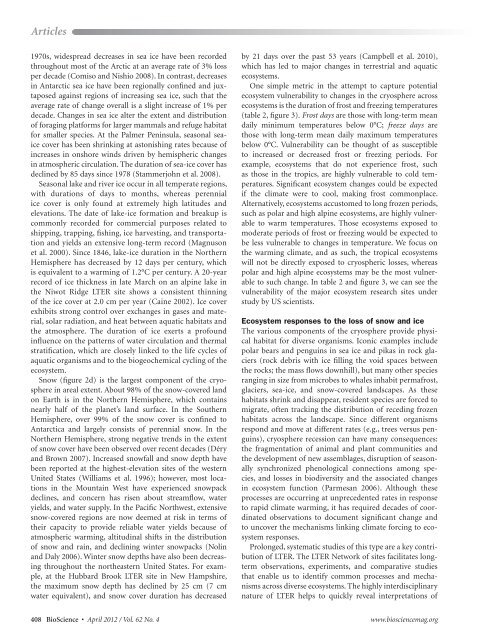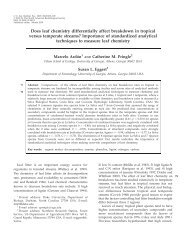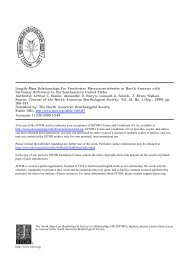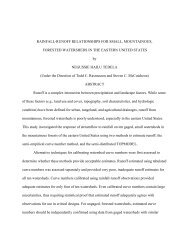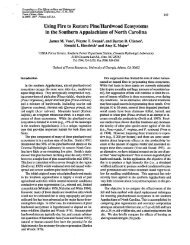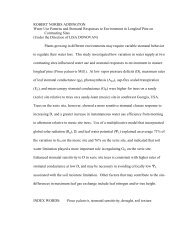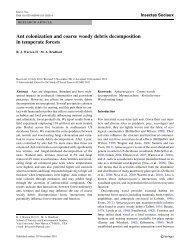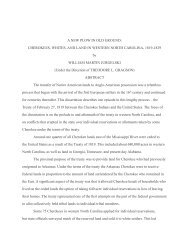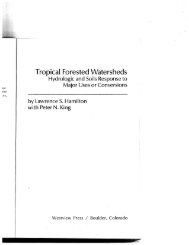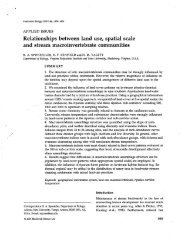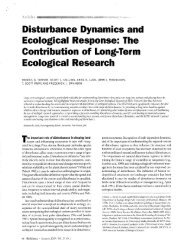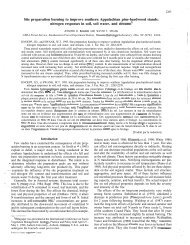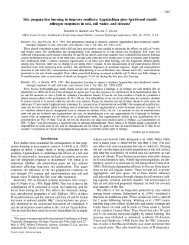biology join - Coweeta LTER - University of Georgia
biology join - Coweeta LTER - University of Georgia
biology join - Coweeta LTER - University of Georgia
You also want an ePaper? Increase the reach of your titles
YUMPU automatically turns print PDFs into web optimized ePapers that Google loves.
Articles<br />
1970s, widespread decreases in sea ice have been recorded<br />
throughout most <strong>of</strong> the Arctic at an average rate <strong>of</strong> 3% loss<br />
per decade (Comiso and Nishio 2008). In contrast, decreases<br />
in Antarctic sea ice have been regionally confined and juxtaposed<br />
against regions <strong>of</strong> increasing sea ice, such that the<br />
average rate <strong>of</strong> change overall is a slight increase <strong>of</strong> 1% per<br />
decade. Changes in sea ice alter the extent and distribution<br />
<strong>of</strong> foraging platforms for larger mammals and refuge habitat<br />
for smaller species. At the Palmer Peninsula, seasonal seaice<br />
cover has been shrinking at astonishing rates because <strong>of</strong><br />
increases in onshore winds driven by hemispheric changes<br />
in atmospheric circulation. The duration <strong>of</strong> sea-ice cover has<br />
declined by 85 days since 1978 (Stammerjohn et al. 2008).<br />
Seasonal lake and river ice occur in all temperate regions,<br />
with durations <strong>of</strong> days to months, whereas perennial<br />
ice cover is only found at extremely high latitudes and<br />
elevations. The date <strong>of</strong> lake-ice formation and breakup is<br />
commonly recorded for commercial purposes related to<br />
shipping, trapping, fishing, ice harvesting, and transportation<br />
and yields an extensive long-term record (Magnuson<br />
et al. 2000). Since 1846, lake-ice duration in the Northern<br />
Hemisphere has decreased by 12 days per century, which<br />
is equivalent to a warming <strong>of</strong> 1.2°C per century. A 20-year<br />
record <strong>of</strong> ice thickness in late March on an alpine lake in<br />
the Niwot Ridge <strong>LTER</strong> site shows a consistent thinning<br />
<strong>of</strong> the ice cover at 2.0 cm per year (Caine 2002). Ice cover<br />
exhibits strong control over exchanges in gases and material,<br />
solar radiation, and heat between aquatic habitats and<br />
the atmosphere. The duration <strong>of</strong> ice exerts a pr<strong>of</strong>ound<br />
influence on the patterns <strong>of</strong> water circulation and thermal<br />
stratification, which are closely linked to the life cycles <strong>of</strong><br />
aquatic organisms and to the biogeochemical cycling <strong>of</strong> the<br />
ecosystem.<br />
Snow (figure 2d) is the largest component <strong>of</strong> the cryosphere<br />
in areal extent. About 98% <strong>of</strong> the snow-covered land<br />
on Earth is in the Northern Hemisphere, which contains<br />
nearly half <strong>of</strong> the planet’s land surface. In the Southern<br />
Hemisphere, over 99% <strong>of</strong> the snow cover is confined to<br />
Antarctica and largely consists <strong>of</strong> perennial snow. In the<br />
Northern Hemisphere, strong negative trends in the extent<br />
<strong>of</strong> snow cover have been observed over recent decades (Déry<br />
and Brown 2007). Increased snowfall and snow depth have<br />
been reported at the highest-elevation sites <strong>of</strong> the western<br />
United States (Williams et al. 1996); however, most locations<br />
in the Mountain West have experienced snowpack<br />
declines, and concern has risen about streamflow, water<br />
yields, and water supply. In the Pacific Northwest, extensive<br />
snow- covered regions are now deemed at risk in terms <strong>of</strong><br />
their capacity to provide reliable water yields because <strong>of</strong><br />
atmospheric warming, altitudinal shifts in the distribution<br />
<strong>of</strong> snow and rain, and declining winter snowpacks (Nolin<br />
and Daly 2006). Winter snow depths have also been decreasing<br />
throughout the northeastern United States. For example,<br />
at the Hubbard Brook <strong>LTER</strong> site in New Hampshire,<br />
the maximum snow depth has declined by 25 cm (7 cm<br />
water equivalent), and snow cover duration has decreased<br />
by 21 days over the past 53 years (Campbell et al. 2010),<br />
which has led to major changes in terrestrial and aquatic<br />
ecosystems.<br />
One simple metric in the attempt to capture potential<br />
ecosystem vulnerability to changes in the cryosphere across<br />
ecosystems is the duration <strong>of</strong> frost and freezing temperatures<br />
(table 2, figure 3). Frost days are those with long-term mean<br />
daily minimum temperatures below 0°C; freeze days are<br />
those with long-term mean daily maximum temperatures<br />
below 0°C. Vulnerability can be thought <strong>of</strong> as susceptible<br />
to increased or decreased frost or freezing periods. For<br />
example, ecosystems that do not experience frost, such<br />
as those in the tropics, are highly vulnerable to cold temperatures.<br />
Significant ecosystem changes could be expected<br />
if the climate were to cool, making frost commonplace.<br />
Alternatively, ecosystems accustomed to long frozen periods,<br />
such as polar and high alpine ecosystems, are highly vulnerable<br />
to warm temperatures. Those ecosystems exposed to<br />
moderate periods <strong>of</strong> frost or freezing would be expected to<br />
be less vulnerable to changes in temperature. We focus on<br />
the warming climate, and as such, the tropical ecosystems<br />
will not be directly exposed to cryospheric losses, whereas<br />
polar and high alpine ecosystems may be the most vulnerable<br />
to such change. In table 2 and figure 3, we can see the<br />
vulnerability <strong>of</strong> the major ecosystem research sites under<br />
study by US scientists.<br />
Ecosystem responses to the loss <strong>of</strong> snow and ice<br />
The various components <strong>of</strong> the cryosphere provide physical<br />
habitat for diverse organisms. Iconic examples include<br />
polar bears and penguins in sea ice and pikas in rock glaciers<br />
(rock debris with ice filling the void spaces between<br />
the rocks; the mass flows downhill), but many other species<br />
ranging in size from microbes to whales inhabit permafrost,<br />
glaciers, sea-ice, and snow-covered landscapes. As these<br />
habitats shrink and disappear, resident species are forced to<br />
migrate, <strong>of</strong>ten tracking the distribution <strong>of</strong> receding frozen<br />
habitats across the landscape. Since different organisms<br />
respond and move at different rates (e.g., trees versus penguins),<br />
cryosphere recession can have many consequences:<br />
the fragmentation <strong>of</strong> animal and plant communities and<br />
the development <strong>of</strong> new assemblages, disruption <strong>of</strong> seasonally<br />
synchronized phenological connections among species,<br />
and losses in biodiversity and the associated changes<br />
in ecosystem function (Parmesan 2006). Although these<br />
processes are occurring at unprecedented rates in response<br />
to rapid climate warming, it has required decades <strong>of</strong> coordinated<br />
observations to document significant change and<br />
to uncover the mechanisms linking climate forcing to ecosystem<br />
responses.<br />
Prolonged, systematic studies <strong>of</strong> this type are a key contribution<br />
<strong>of</strong> <strong>LTER</strong>. The <strong>LTER</strong> Network <strong>of</strong> sites facilitates longterm<br />
observations, experiments, and comparative studies<br />
that enable us to identify common processes and mechanisms<br />
across diverse ecosystems. The highly interdisciplinary<br />
nature <strong>of</strong> <strong>LTER</strong> helps to quickly reveal interpretations <strong>of</strong><br />
408 BioScience • April 2012 / Vol. 62 No. 4 www.biosciencemag.org


